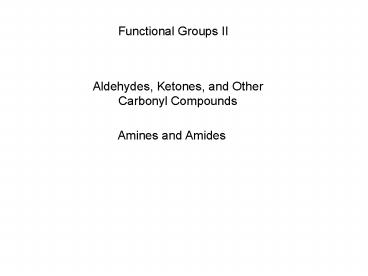Aldehydes, Ketones, and Other Carbonyl Compounds - PowerPoint PPT Presentation
1 / 25
Title:
Aldehydes, Ketones, and Other Carbonyl Compounds
Description:
Oxygen is one of the electronegative elements: by nature, oxygen keeps electrons ... Nitrogen is a very electronegative element compared with hydrogen. ... – PowerPoint PPT presentation
Number of Views:57
Avg rating:3.0/5.0
Title: Aldehydes, Ketones, and Other Carbonyl Compounds
1
Functional Groups II
Aldehydes, Ketones, and Other Carbonyl Compounds
Amines and Amides
2
Learning Objectives
Identify, describe structurally, and recognize an
amine, carbonyl group, aldehyde, ketone, ester,
and amide.
Identify and recognize a heterocyclic compound.
Identify and recognize a primary, secondary,
tertiary, and quaternary amine.
Recognize and describe an esterification
reaction, especially with respect to the
reactants and structure of product.
Recognize and describe the amide bond formation
between two amino acids.
3
Definitions
carbonyl compound any compound that contains a
carbonyl group CO.
carbonyl group a functional group that has a
carbon atom joined to an oxygen by a double bond
aldehyde a compound that has a carbonyl group
bonded to one carbon and one hydrogen, RCHO.
ketone a compound that has a carbonyl group
bonded to two carbons of organic groups that can
be the same or different, R2CO or RRCO
carboxylic acid a compound that has a carbonyl
group bonded to a carbon atom (of an organic
group) and an OH group, RCOOH.
4
Definitions
ester a compound that has a carbonyl group
bonded to the carbon of an organic group and an
OR group where R is another organic group, RCOOR
or RCOOR.
esterification the reaction between an alcohol
and a carboxylic acid to yield an ester plus
water.
amines a compound that has one or more organic
groups bonded to a nitrogen. amino the NH2
functional group heterocyclic compounds a
compound with a ring structure that contains
within the ring some atom other than carbon,
typically nitrogen.
amide a compound that has a carbonyl group
bonded to a carbon atom and to a nitrogen atom
group, RCONR2
5
carbonyl compound any compound that contains a
carbonyl group CO.
carbonyl group a functional group that has a
carbon atom joined to an oxygen by a double bond
C O
CO
the carbonyl group
6
Oxygen is one of the electronegative elements by
nature, oxygen keeps electrons around its
nucleus oxygen also has two pairs of unshared
electrons. An oxygen-carbon bond is polar it has
two poles, one partially positive and one
partially negative.
7
aldehyde a compound that has a carbonyl group
bonded to one carbon and one hydrogen, RCHO.
O
C
H
R
8
ketone a compound that has a carbonyl group
bonded to two carbons of organic groups that can
be the same or different, R2CO or RRCO
O
O
C
R
R
C
R
R
Acetone
9
carboxylic acid a compound that has a carbonyl
group bonded to a carbon atom (of an organic
group) and an OH group, RCOOH.
O
C
OH
R
10
Acetic acid
CH3COOH
11
OH
O
CH3-CH-COOH
CH3-C-COOH
Pyruvic acid
Lactic acid
(pyruvate)
(lactate)
CH3(CH2)16COOH
Stearic acid
Stearic acid is a 18-carbon, saturated, naturally
occurring fatty acid.
12
COOH
NH2
CH3-CH-COOH
Alanine
Benzoic acid
Alanine is an amino acid.
13
ester a compound that has a carbonyl group
bonded to the carbon of an organic group and an
OR group where R is another organic group, RCOOR
or RCOOR.
O
C
OR
R
O
C
OR
R
14
Esters are formed by the addition of an alcohol
to a carboxylic acid an esterification reaction.
O
O
C
OR2
R1
C
OH
R1
R2
OH
H2O
esterification the reaction between an alcohol
and a carboxylic acid to yield an ester plus
water.
15
CH2-CH-CH2
CH3(CH2)16COOH
OH
OH
OH
stearic acid
glycerol
CH2-CH-CH2
OH
OH
O
H2O
CO
(CH2)16CH3
Esterification of a fatty acid to glycerol
16
Nitrogen
Elemental symbol N Atomic Number 7
Electron Configuration 1s2 2s2 2p3
Number of valence electrons 5
Hybridization of orbitals sp3, sp2, sp
17
sp3 hybridization in nitrogen four equivalent
orbitals three that contain one electron each,
and one orbital with two, unshared electrons.
Ammonia
NH3
N
N
The bonding geometry of sp3 nitrogen is pyramidal
(a type of tetrahedral) and the lone pair of
electrons (which occupies one position of the
tetrahedral) is not usually shown.
18
Nitrogen is a very electronegative element
compared with hydrogen. The N-H bond is polar
(similar to the O-H bond). Consequently, N
acquires a partial negative charge, and hydrogen
acquires a partial positive charge.
d-
d
N
H
Amines can participate in hydrogen bonding.
19
H
O
R
H
H
N
N
H
H
N
R
H
H
H
R
CH3-CH2-O
H
O
H
H
CH3
Hydrogen bonding in amines
CH2
O
H
20
Ethylamine, a primary amine
R
NH2
Diethylamine, a secondary amine
H
N
R
R
21
Triethylamine, a tertiary amine
R
N
R
R
22
Acetylcholine, a neurotransmitter
(a quaternary amine)
R
N
R
R
R
23
Heterocyclic compounds
These are the parent compounds of the pyrimidine
and purine bases of the nucleic acids, DNA and
RNA.
24
amide a compound that has a carbonyl group
bonded to a carbon atom and to a nitrogen atom
group, RCONR2
O
C
NH2
R
O
C
NHR
R
O
R
C
N
R
R
25
Peptide bond formation
The peptide bond of proteins is formed between
the carboxyl group of one amino acid and the
amino group of another amino acid. The peptide
bond of proteins is an amide, or amide linkage.
NH2
CH2-COOH
NH2
CH3-CH-COOH
glycine
alanine
H2N
O
CH3-CH
C
NH
CH2-COOH
H2O
amide linkage































